
What to consider
The entryway – a space with clear functionality: here we dress as we leave the apartment and undress upon returning. Therefore, storage should be organized in such a way that these actions are as convenient as possible. Additionally, several other important points need to be considered:
- Dirt quickly accumulates in the entry area, especially from autumn to spring, when it’s almost always slush, puddles, or snow (sometimes all at once).
- The room is usually small in area, and in Khrushchyovkas and panel buildings, it’s only a few square yards. Additionally, there’s the inconvenient elongated shape.
- In small apartments, the entryway often concentrates the main storage. Space needs to be found for suitcases, seasonal items, household belongings, and much more.
Based on this, even in a tiny entry area, diverse storage needs to be organized:
- For items needed every day
- For small items we take with us when leaving the apartment.
- For outdoor footwear and wet outerwear.



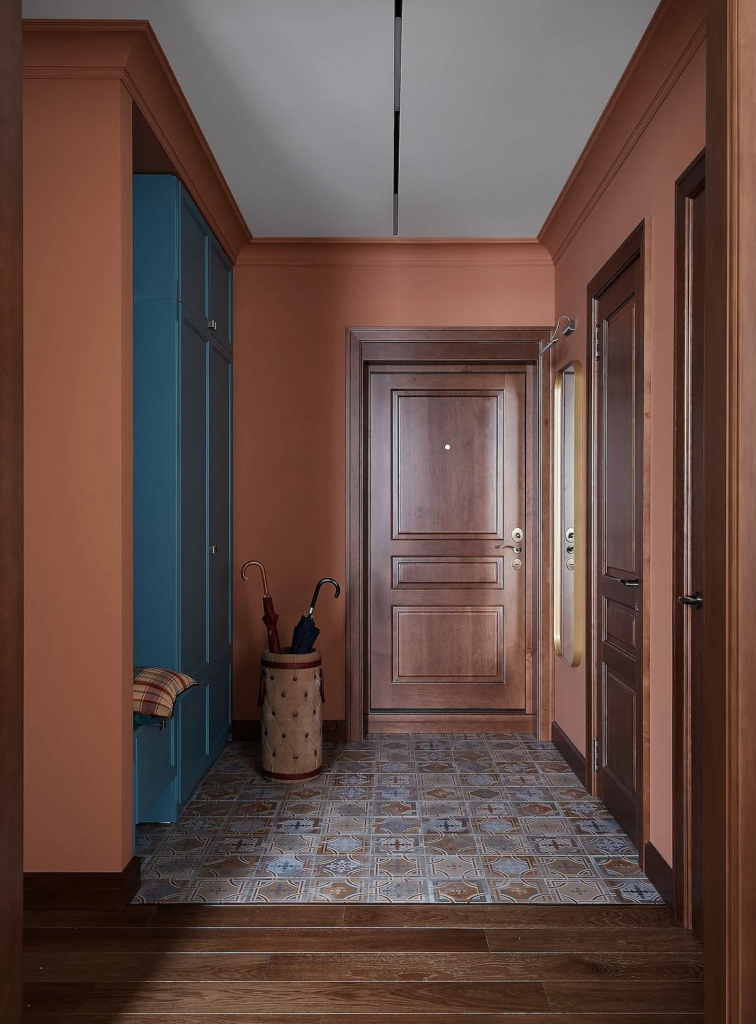




Main storage
The primary storage system could be a wardrobe closet in the entryway, a small chest of drawers, or even a walk-in closet, depending on the apartment’s size and the volume of items.
Wardrobe in the entryway

The most common option is a wardrobe. In most cases, you can find a suitable ready-made model in terms of size and configuration. If a more complex solution is needed, a custom system can be made.
Wardrobes come in different designs:
- Swing-door – with classic doors that open outward. The big advantage of such wardrobes is the variety of dimensions: for example, there are compact models up to 30 cm deep. The downsides could include lower capacity and the door opening mechanism – there needs to be space in front of the wardrobe to open the doors freely.
- Sliding-door – a popular option for any room, including the entryway. The doors of a sliding-door wardrobe slide to the side, so there’s no need to leave empty space in front, making it possible to fit even into a narrow corridor. The depth of a sliding-door wardrobe is usually 60 cm or more, and the width can be chosen as desired: from a minimal set of two sections to a large construction with 5-6 doors.
- Any of these wardrobes can be freestanding (separate, on legs or base, with three walls and doors) or built-in (mounted into a specially prepared niche exactly to the size of the structure, often without back and side walls). The advantage of freestanding furniture is that it can simply be placed anywhere, and if necessary, moved to another place. It doesn’t require complex assembly but provides slightly less capacity. Built-in models allow using space with maximum efficiency, utilizing every centimeter. However, the construction will be immobile.


Walk-in closet
In recent years, a walk-in closet has become almost a mandatory element of any apartment.

Even in a small space, it’s possible to allocate at least a couple of square yards. One of the best places for this (alongside the bedroom) is in the entryway since this is usually where a large array of items is stored. Having a separate space, albeit small, allows you to:
- Conveniently organize different types of items (seasonal, household, shoes, bags and suitcases, sports gear).
- Free up other storage systems in the apartment.
- Protect items from street dirt and dust.
- Save money, as on average, filling a walk-in closet costs less than a separate large wardrobe.
For separate storage in the entryway, you can allocate a separate room if the layout and size of the dwelling allow. Additionally, a mini walk-in closet can be conveniently organized in a niche. If you close it with doors, you’ll get a deep wardrobe closet. You can also use a thick curtain or leave the space completely open — but in this case, ensure that the clothing is protected from dirt. It’s better to store it not on open shelves in the entryway but to have as many closed sections as possible.
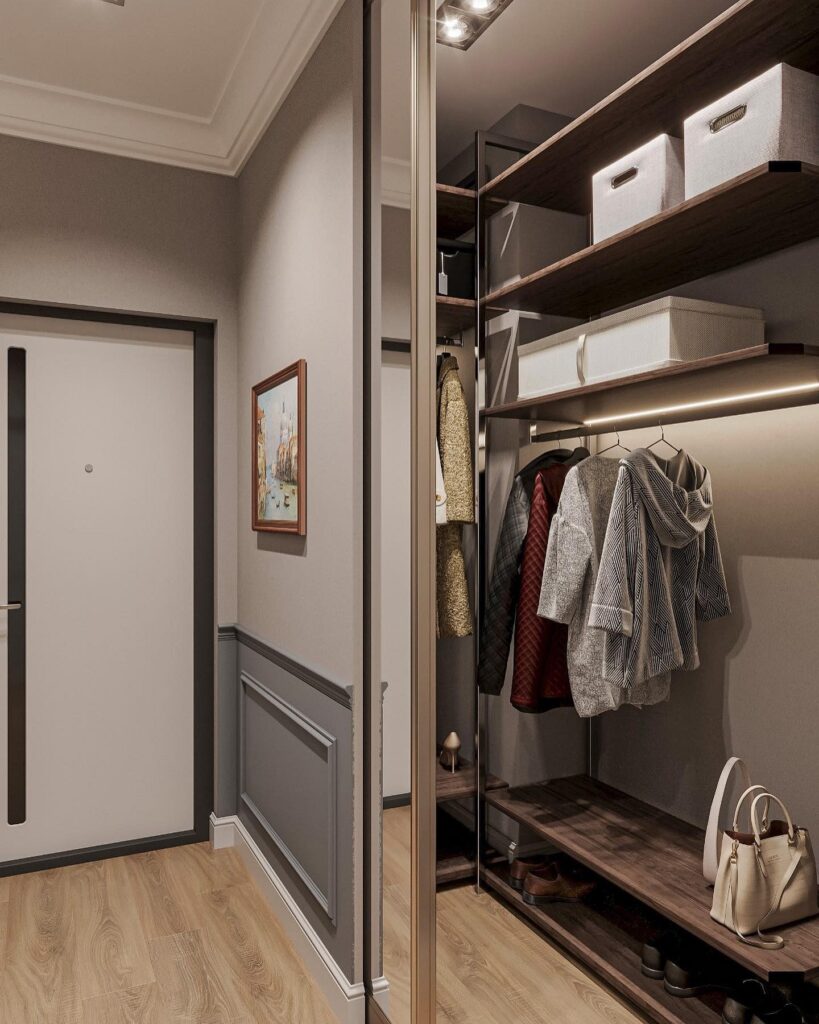
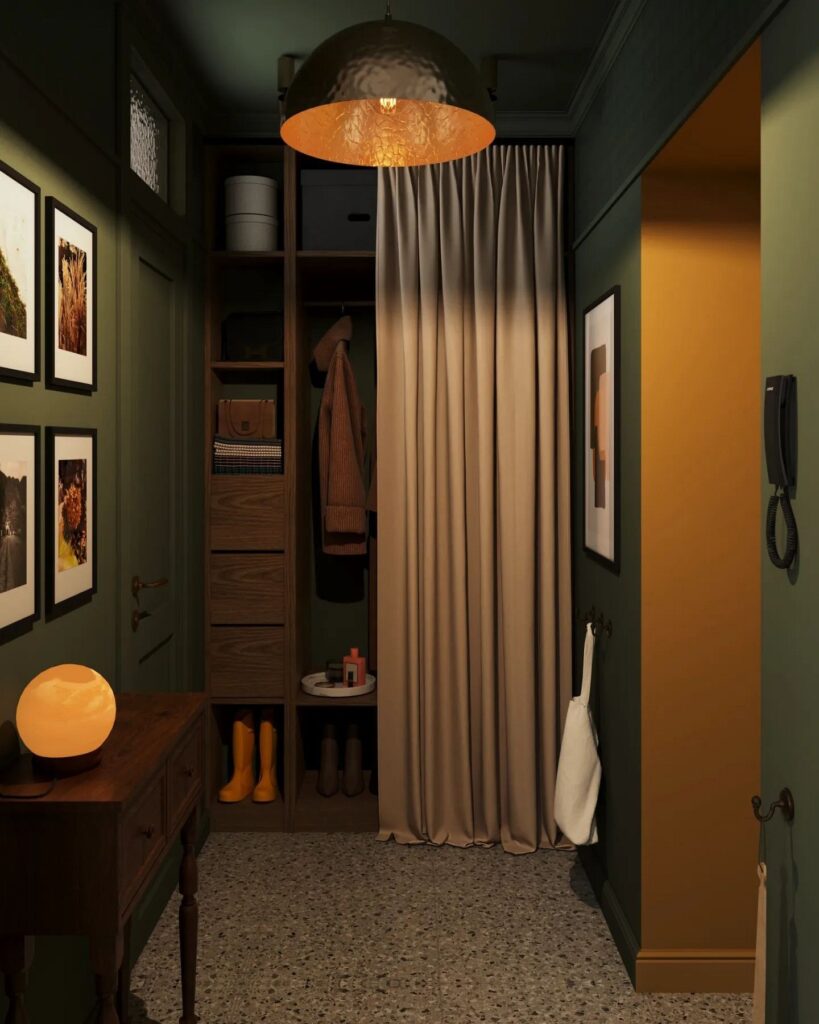

Modular storage system
An excellent solution for a standard small entryway is a combined storage system.

Usually, it includes:
- Closed section (wardrobe for clothing, suitcases, or household belongings).
- Open section with hooks for clothes.
- Shoe rack or shelves for shoes.
- Seating for comfortable changing.
Some of these elements may be absent or, conversely, other elements may be added: shelves for accessories, mounts for bicycles or skis, drawers, or additional hangers, etc.




Shelf or dresser
Finally, it may be the case that there’s no space at all in the entryway (for example, in a mini-studio or a Khrushchyovka).

In this case, you need to move as much storage as possible to other rooms and leave only the necessary minimum in the entryway. Any compact furniture will suffice:
- Dresser with several drawers.
- Hanging or floor-standing console on thin legs.
- Shelf with open shelves (boxes or baskets can be placed on them to organize small items more conveniently and aesthetically).




Shoes
The next important step is to organize shoe storage in the entryway. It should accomplish two tasks: not create a mess and simplify maintaining cleanliness in the entry area.

Everyday shoes can be left on the floor near the door, but in bad weather, this can lead to pooled puddles and dried mud, which will then spread throughout the house. Therefore, for those pairs that you take off and put on constantly, it’s better to allocate a corner and either lay down a rubber mat or place a tray where all the dirty water will drain.
As for the rest of the shoe collection, including boots, sneakers, and boots, it’s better to create a separate storage system. This could be a closed shoe cabinet with sliding or folding drawers, a couple of shelves, or a special compartment at the bottom of the wardrobe. The main thing is to place only clean, dry shoes there to prevent them from getting musty and to avoid unpleasant odors and mold inside.








Outerwear
In addition to shoes, outerwear also accumulates when entering the apartment — it also needs to be given a place.
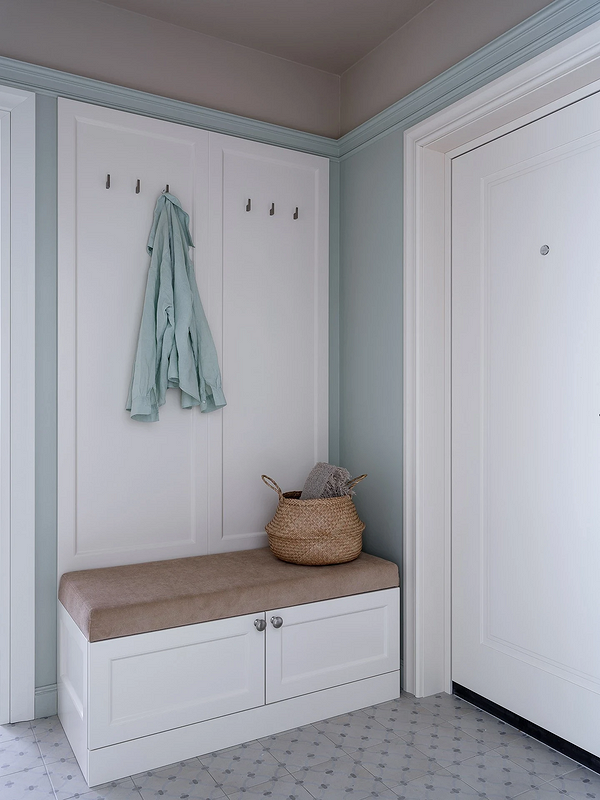
For this, you can place a floor coat rack or hang hooks on the wall — the quantity depends on how many people live in the apartment, plus a small reserve for guests. In addition to jackets and coats, we also use accessories: scarves, hats, gloves. They also need to be easily accessible, so a coat rack is often complemented by one or several shelves where you can put all these items.
Long scarves, as well as bags, are convenient to hang on the same hooks — you can even make a separate section for them so as not to overload the coat rack with clothing. In the photo gallery are examples of how an entryway with shelves and coat racks can look.





Details
Finally, it’s necessary to think through the storage of details—and this isn’t as simple as it seems at first glance.

The thing is, it’s the small items like keys, business cards, passes, cosmetics, and perfumes that, firstly, create visual clutter and tangible disorder. Secondly, they often get lost, which ultimately leads to rush during gatherings, resulting in stress and lateness.
Therefore, logistics must be well thought out. And not just from a visual perspective but also considering real-life scenarios. You need to realize that you won’t neatly arrange all the details on shelves, hang hooks on different hooks, and put sunglasses first in a case, and then in a specially designated place in the closet.
To ensure neat and convenient storage of small items in everyday life:
- Combine open and closed sections. A hallway with storage drawers looks tidier than just cluttered shelves.
- Use organizers where you can quickly sweep away the details and then, if necessary, sort them out.
- Group and use quick visual markers. For example, you can buy identical trays of different colors for the drawer and keep keys in one, cards in another, and small items in a third. This way, you will immediately, even at a glance, understand where everything is located.
- Try to maximize the use of all vertical surfaces. If the hallway is narrow or very small, raise storage to the walls using shelves, hooks, and hanging shelf modules.



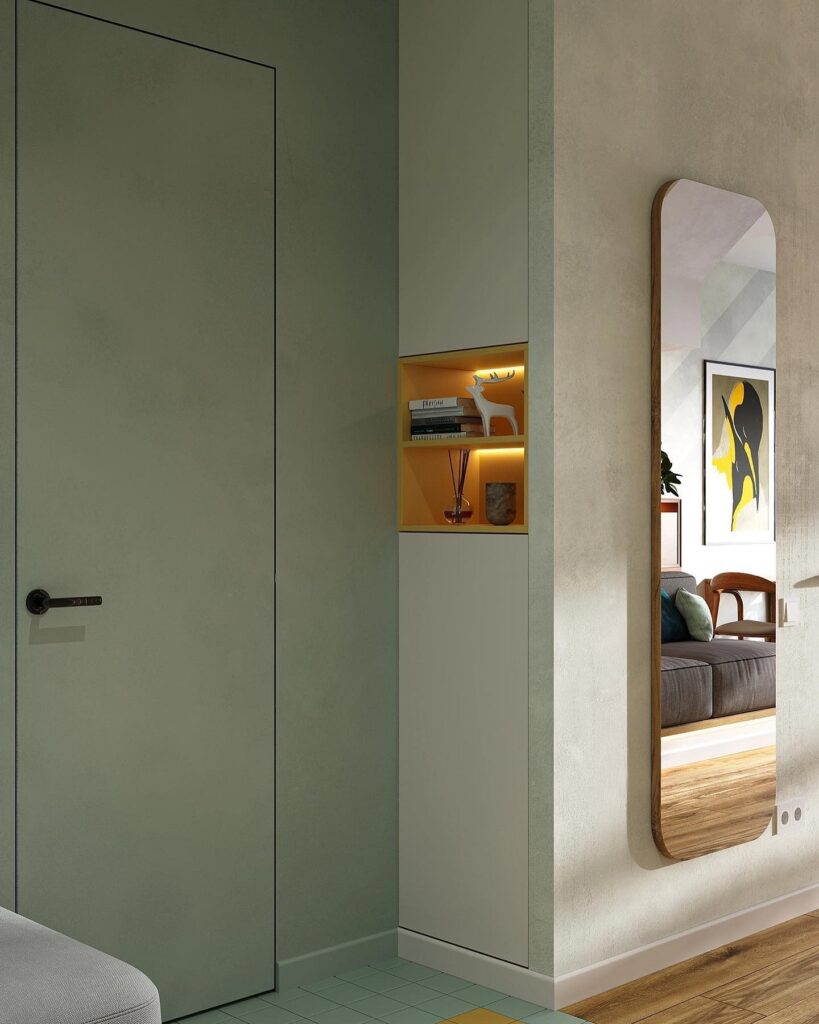
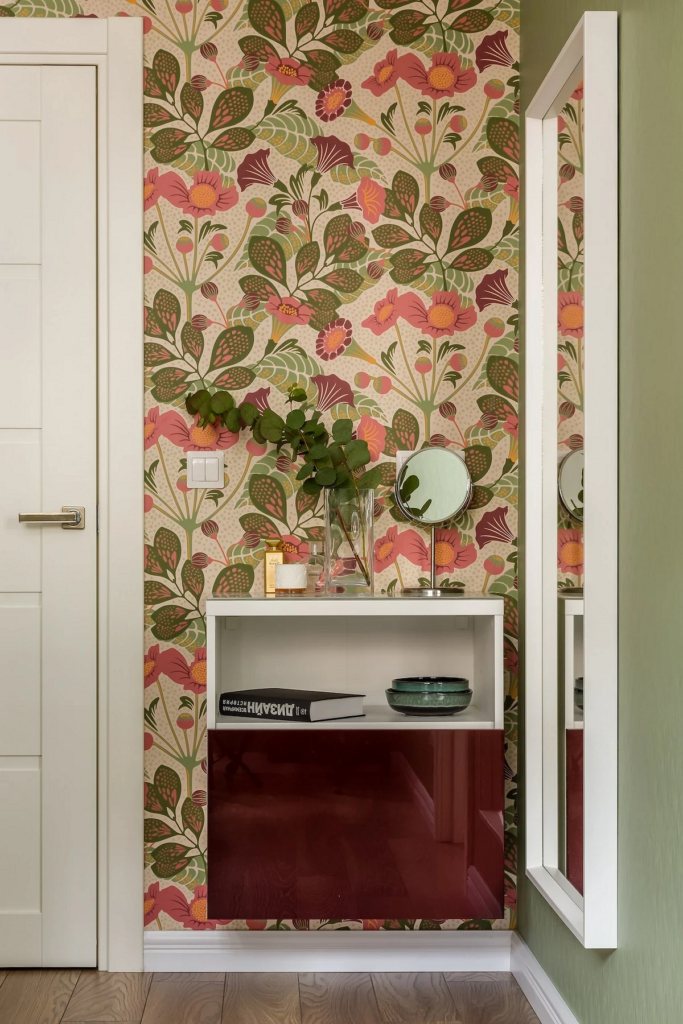






Leave feedback about this